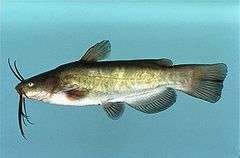Brown bullhead
| Brown bullhead | |
|---|---|
 | |
| Scientific classification | |
| Kingdom: | Animalia |
| Phylum: | Chordata |
| Class: | Actinopterygii |
| Order: | Siluriformes |
| Family: | Ictaluridae |
| Genus: | Ameiurus |
| Species: | A. nebulosus |
| Binomial name | |
| Ameiurus nebulosus Lesueur, 1819 | |
| Synonyms | |
|
Ictalurus nebulosus (Lesueur, 1819) | |
The brown bullhead (Ameiurus nebulosus) is a fish of the Ictaluridae family that is widely distributed in North America. It is a species of bullhead catfish and is similar to the black bullhead (Ameiurus melas) and yellow bullhead (Ameiurus natalis). It was originally described as Pimelodus nebulosus by Charles Alexandre Lesueur in 1819, and is also referred to as Ictalurus nebulosus.
The brown bullhead is also widely known as the "mud pout," "horned pout," "hornpout," or simply "mud cat," along with the other bullhead species.
The brown bullhead is important as a clan symbol of the Ojibwe group of Native Americans. In their tradition, the bullhead or "wawaazisii" is one of six beings that came out of the sea to form the original clans.[2] The Brown Bullhead attains a length of up to 21 in (53 cm).[3]
Habitat
The brown bullhead thrives in a variety of habitats, including lakes and ponds with low oxygen and/or muddy conditions. In many areas of the United States, brown bullheads are opportunistic bottom feeders. It has few natural predators and is not popular with fishermen, so it has thrived. For native fish species, this predatory fish is a disaster. Catfish are found in a variety of habitats, from lakes or murky ponds to drainage ditches. They are scarce during the day but come out at night to feed, searching the bottom of a lake or river for food.[4] They eat insects, leeches, snails, fish, clams, and many plants. They are also known to eat corn, which can be used as bait. Similar to other catfish, they spawn only after the temperature of the water has reached 80 degrees Fahrenheit (27 °C) (cooler in the northern US) in June and July.

Fishing
This catfish is easily caught with natural bait such as worms and chicken livers. They have a scrappy but not unusually strong fight. Anglers often catch them by fishing off the bottom. When caught in very clear water when the flesh is firm and reddish to pinkish, the hornpout is quite edible and delicious. Nevertheless, its genial cousins such as the channel catfish and the blue catfish are better known for their consumption qualities. In most areas, they will not exceed two pounds in weight, with a current IGFA world's record of 7 lb 6oz, by Glenn Collacuro, Lake Mahopac NY, August 1, 2009.[5]
Invasive species
The fish has been introduced into many European countries such as Germany, Sweden, Norway, Finland, Romania and Estonia as well as Western North America, Chile, Puerto Rico and New Zealand.[6]
See also
- Bullhead catfish (general)
- Rough fish
References
- ↑ NatureServe (2015). "Ameiurus nebulosus". IUCN Red List of Threatened Species. Version 4.1 (4.1). International Union for Conservation of Nature. Retrieved February 25, 2016.
- ↑ http://www.glifwc.org/pub/fall99/clansystem.htm
- ↑ (Petersons field guide to freshwater fishes of North America north of Mexico)
- ↑ "Brown Bullhead Catfish." Aliens Among Us. N.p., n.d. Web. 27 Oct. 2014. <http://alienspecies.royalbcmuseum.bc.ca/eng/species/brown-bullhead-catfish>.
- ↑ IGFA Brown Bullhead Records
- ↑ "Ictalurus nebulosus". ISSG. 11 April 2006. Retrieved 17 July 2010.
External links
| Wikimedia Commons has media related to Ameiurus nebulosus. |
| Wikispecies has information related to: Ameiurus nebulosus |
- Froese, Rainer and Pauly, Daniel, eds. (2007). "Ameiurus nebulosus" in FishBase. February 2007 version.
- Ameiurus nebulosus, German language; originally published in: Datz-Aquarienpraxis 11/2004, S. 10f.
